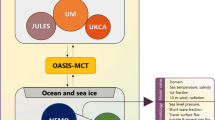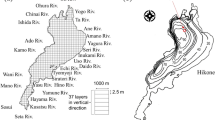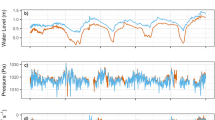Abstract
A generalized model is presented to estimate the diurnal cycle of hourly net ecosystem exchange (NEE) based on a corresponding single reference-time observation from the Florida Everglades freshwater wetlands. The year-round diurnal cycles of NEE for two different (short vs. long hydroperiod) marsh sites were normalized by the corresponding day- and site-specific reference observations of NEE to obtain a common dimensionless cycle. An extended stochastic harmonic analysis (ESHA) was utilized to calibrate and validate the model with hourly eddy-covariance observations of NEE during 2008–13. The model involved five parameters, which exhibited spatiotemporal robustness by collapsing into narrow ranges among different days, years and sites. The daily estimates were averaged over all calibration days to calculate the site-specific ensemble parameter sets. The site-specific ensemble parameters were further averaged over four mid-day reference times (11 A.M. to 2 P.M.) across sites to obtain a generalized ensemble parameter set. Estimated hourly NEE using the site-specific and the generalized parameter sets indicated a good performance of the model (e.g., Nash-Sutcliffe Efficiency, NSE = 0.66–0.89). The model is represented in three standalone formats, including an Excel spreadsheet, to simulate the hourly NEE for the desired Julian days and years from the respective single reference observations.









Similar content being viewed by others
References
Abdul-Aziz OI, Ishtiaq KS (2014) Robust empirical modeling of dissolved oxygen in small rivers and streams: scaling by a single reference observation. Journal of Hydrology 511:648–657
Abdul-Aziz OI, Wilson BN, Gulliver JS (2007) An extended stochastic harmonic analysis (ESHA) algorithm: application for dissolved oxygen. Water Resources Research 43, doi:10.1029/2006WR005530
Akaike H (1974) A new look at the statistical model identification. IEEE Transactions on Automatic Control 19(6):716–723
AmeriFlux (2016) Data retrieved from http://ameriflux.lbl.gov/ Accessed 01 September 2016
Aubinet M, Vesala T, Papale D (2012) Eddy Covariance: a practical guide to measurement and data analysis. Springer Science and Business Media, New York
Beer C, Reichstein M, Tomelleri Ciais EP, Jung M, Carvalhais N, Rödenbeck C, Arain MA, Baldocchi D, Bonan GB, Bondeau A, Cescatti A, Lasslop G, Lindroth A, Lomas M, Luyssaert S, Margolis H, Oleson KW, Roupsard O, Veenendaal E, Viovy N, Williams C, Woodward FI, Papale D (2010) Terrestrial gross carbon dioxide uptake: global distribution and covariation with climate. Science 329(5993):834–838
Bridgham SD, Megonigal JP, Keller JK, Bliss NB, Trettin C (2006) The carbon balance of north American wetlands. Wetlands 26(4):889–916
Cox DR, Lewis PW (1966) The statistical analysis of series of events. Methuen, London
Dyar TR, Alhadeff SJ (2005) Dissolved oxygen characteristics of Georgia streams. Proceedings, 2005 Georgia Water Resources Conference. University of Georgia, Athens, 25–27 April
Enquist BJ, Economo EP, Huxman TE, Allen AP, Ignace DD, Gillooly JF (2003) Scaling metabolism from organisms to ecosystems. Nature 423(6940):639–642
Ewe SML, Gaiser EE, Childers DL, Iwaniec D, Rivera-Monroy VH, Twilley RR (2006) Spatial and temporal patterns of aboveground net primary productivity (ANPP) along two freshwater-estuarine transects in the Florida Coastal Everglades. Hydrobiologia 569:459–474
Falge E, Baldocchi D, Olson R et al (2001) Gap filling strategies for defensible annual sums of net ecosystem exchange. Agricultural and forest meteorology 107(1):43–69
FCE LTER (2016) Florida Coastal Everglades Long Term Ecological Research. Data retrieved from http://fcelter.fiu.edu/research/sites/ Accessed 01 September 2016
Florida Everglades NEE Model (2017) Florida Everglades Net Ecosystem Exchange Model Software. Available online at https://sites.google.com/view/ecological-water/data-and-models
Griffis TJ, Rouse WR (2001) Modelling the interannual variability of net ecosystem CO2 exchange at a subarctic sedge fen. Global Change Biology 7(5):511–530
Hollinger DY, Aber J, Dail B et al (2004) Spatial and temporal variability in forest–atmosphere CO2 exchange. Global Change Biology 10(10):1689–1706
Hondzo M, Warnaars TA (2008) Coupled effects of small-scale turbulence and phytoplankton biomass in a small stratified lake. Journal of environ. Engineering 134(12):954–960
Hui D, Wan S, Su B, Katul G, Monson R, Luo Y (2004) Gap-filling missing data in eddy covariance measurements using multiple imputation (MI) for annual estimations. Agricultural and Forest Meteorology 121(1):93–111
Jimenez KL, Starr G, Staudhammer CL et al (2012) Carbon dioxide exchange rates from short-and long-hydroperiod Everglades freshwater marsh. Journal of Geophysical Research: Biogeosciences 117:1–17. doi:10.1029/2012JG002117
Kumar MR, Pednekar SM, Katsumata M, Antony MK, Kuroda Y, Unnikrishnan AS (2006) Seasonal variation of the diurnal cycle of rainfall in the eastern equatorial Indian Ocean. Theoretical and applied climatology 85(1–2):117–122
Malone SL, Staudhammer CL, Loescher HW et al (2014a) Seasonal patterns in energy partitioning of two freshwater marsh ecosystems in the Florida Everglades. Journal of Geophysical Research: Biogeosciences 119(8):1487–1505
Malone SL, Staudhammer CL, Oberbauer SF et al (2014b) El Nin˜o southern oscillation (ENSO) enhances CO2 exchange rates in freshwater marsh ecosystems in the Florida Everglades. PLoS ONE 9(12):e115058. doi:10.1371/journal.pone.0115058
Meyers SR, Sageman BB, Hinnov LA (2001) Integrated quantitative stratigraphy of the Cenomanian-Turonian Bridge Creek limestone member using evolutive harmonic analysis and stratigraphic modeling. Journal of Sedimentary Research 71(4):628–644
Milne BT, Gupta VK, Restrepo C (2002) A scale invariant coupling of plants, water, energy, and terrain. Ecoscience 9(2):191–199
Moffat AM, Papale D, Reichstein M et al (2007) Comprehensive comparison of gap-filling techniques for eddy covariance net carbon fluxes. Agricultural and Forest Meteorology 147(3):209–232
Moffat AM, Beckstein C, Churkina G, Mund M, Heimann M (2010) Characterization of ecosystem responses to climatic controls using artificial neural networks. Global Change Biology 16:2737–2749. doi:10.1111/j.1365-2486.2010.02171.x
Moore TR, Bubier JL, Frolking SE, Lafleur PM, Roulet NT (2002) Plant biomass and production and CO2 exchange in an ombrotrophic bog. Journal of Ecology 90(1):25–36
Nahlik AM, Fennessy MS (2016) Carbon storage in US wetlands. Nature Communications 7:13835
Nestler JM, Long KS (1997) Development of hydrological indices to aid cumulative impact analysis of riverine wetlands. Regulated Rivers: Research & Management 13(4):317–334
O’Connor BL, Hondzo M, Dobraca D, LaPara TM, Finlay JC, Brezonik PL (2006) Quantity-activity relationship of denitrifying bacteria and environmental scaling in streams of a forested watershed. Journal of Geophysical Research 111:G04014
Obeysekera J, Browder J, Hornung L, Harwell MA (1999) The natural South Florida system I: climate, geology, and hydrology. Urban Ecosystems 3(3–4):223–244
Papale D, Valentini R (2003) A new assessment of European forests carbon exchanges by eddy fluxes and artificial neural network spatialization. Global Change Biology 9(4):525–535
Papale D, Reichstein M, Aubinet M et al (2006) Towards a standardized processing of net ecosystem exchange measured with eddy covariance technique: algorithms and uncertainty estimation. Biogeosciences 3(4):571–583
Priestley MB (1981) Spectral analysis and time series. Academic Press, London
Richardson AD, Hollinger DY (2005) Statistical modeling of ecosystem respiration using eddy covariance data: maximum likelihood parameter estimation, and Monte Carlo simulation of model and parameter uncertainty, applied to three simple models. Agricultural and Forest Meteorology 131(3):191–208
Sagerfors J, Lindroth A, Grelle A, Klemedtsson L, Weslien P, Nilsson, M. (2008) Annual CO2 exchange between a nutrient-poor, minerotrophic, boreal mire and the atmosphere. Journal of Geophysical Research: Biogeosciences (2005–2012), 113:G01001. doi:10.1029/2006JG000306
Schedlbauer JL, Oberbauer SF, Starr G, Jimenez KL (2010) Seasonal differences in the CO2 exchange of a short-hydroperiod Florida Everglades marsh. Agricultural and Forest Meteorology 150(7):994–1006
Schedlbauer JL, Oberbauer SF, Starr G, Jimenez KL (2011) Controls on sensible heat and latent energy fluxes from a short-hydroperiod Florida Everglades marsh. Journal of Hydrology 411(3):331–341
Schedlbauer JL, Munyon JW, Oberbauer SF, Gaiser EE, Starr G (2012) Controls on ecosystem carbon dioxide exchange in short-and long-hydroperiod Florida Everglades freshwater marshes. Wetlands 32(5):801–812
Schmidt A, Hanson C, Chan WS, Law BE (2012) Empirical assessment of uncertainties of meteorological parameters and turbulent fluxes in the AmeriFlux network. Journal of Geophysical Research: Biogeosciences (2005–2012) 117: G04014, doi:10.1029/2012JG002100
Stauch VJ, Jarvis AJ (2006) A semi-parametric gap-filling model for eddy covariance CO2 flux time series data. Global Change Biology 12(9):1707–1716
Tukey JW (1977) Exploratory data analysis. Addison-Wesley, Reading, MA
Upton G, Cook I (2006) Oxford dictionary of statistics, 2nd edn. Oxford University Press, Oxford
US Army Corps of Engineers (USACE) and South Florida Water Management District (SFWMD) (1999) Central and southern Florida project comprehensive review study, final integrated feasibility report and programmatic environmental impact statement. USACE, Jacksonville District, Jacksonville and SFWMD, West Palm Beach 4033 pp
Warnaars TA, Hondzo M, Power ME (2007) Abiotic controls on periphyton accrual and metabolism in streams: scaling by dimensionless numbers. Water Resources Research 43:W08425
Williams M, Richardson AD, Reichstein M et al (2009) Improving land surface models with FLUXNET data. Biogeosciences 6(7):1341–1359
Acknowledgements
The research was funded by grants from the National Science Foundation CBET Environmental Sustainability (Award No. 1561941/1336911), and the National Oceanic and Atmospheric Administration (Grant No. NA09NOS4190153 and NA14NOS4190145). The supports are thankfully acknowledged. We are grateful to the Principal Investigators (Dr. Gregory Starr and Dr. Steve Oberbauer) of the following AmeriFlux sites for publicly sharing their data records: Florida Everglades short hydroperiod marsh and Florida Everglades long hydroperiod marsh. Funding for the AmeriFlux data resources was provided by the U.S. Department of Energy’s Office of Science. We also thank two anonymous reviewers and the Associate Editor for providing insightful comments on the primary manuscript.
Author information
Authors and Affiliations
Corresponding author
Rights and permissions
About this article
Cite this article
Ishtiaq, K.S., Abdul-Aziz, O.I. A Generalized Model of Hourly Net Ecosystem Exchange (NEE) for Florida Everglades Freshwater Wetlands. Wetlands 37, 925–939 (2017). https://doi.org/10.1007/s13157-017-0928-y
Received:
Accepted:
Published:
Issue Date:
DOI: https://doi.org/10.1007/s13157-017-0928-y




